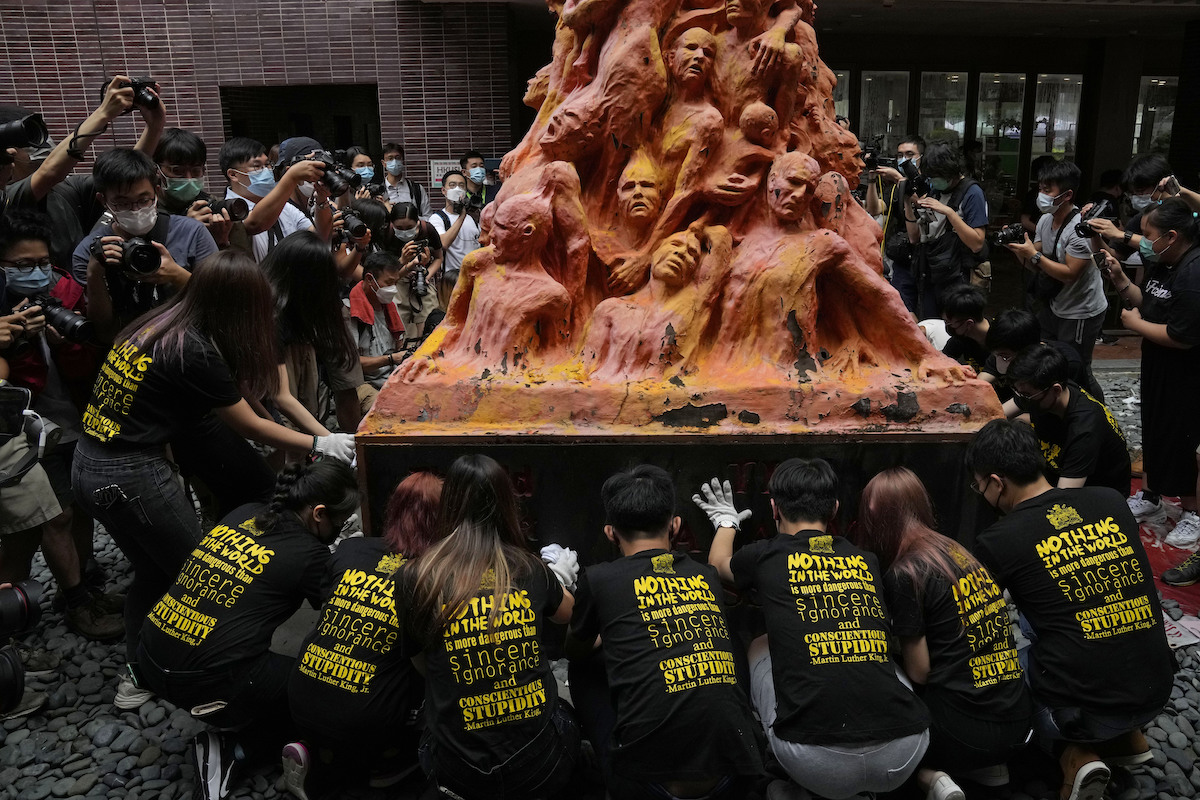The University of Hong Kong requested that members of a prominent but now-disbanded social rights group remove from campus grounds its famous statue, the Pillar of Shame, which pays tribute to victims in Beijing’s violent crackdown during the 1989 Tiananmen Square protests.
The group, Hong Kong Alliance in Support of Patriotic Democratic Movements of China, which was established during the Tiananmen Square protests, received the university’s request for removal on Oct. 8, requiring that the statue be gone no later than Oct. 13 at 5 p.m.
The gruesome sculpture, colored in red, orange, and pink, and a towering 26 feet tall, has stood atop a podium in the Haking Wong building of the university for the past 24 years. At its foundation, an etched phrase reads, “The old cannot kill the young.”
The letter came from Mayer Brown LLP, a London-based international law firm representing the university. Other than the request to remove the statue, the letter did not go into much more detail. Two liquidators from the Alliance, Richard Tsoi and Elizabeth Tang, asked the university to clarify their reasoning behind the request.
If the Alliance fails to remove the Pillar of Shame before the deadline, “the sculpture will be deemed abandoned and the University will not consider any future request from you in respect of the Sculpture, and the University will deal with the Sculpture at such time and in such manner as it thinks fit without further notice,” the letter entailed, according to the Hong Kong Free Press.
Tsoi, a retired member of the Alliance, called the request “unreasonable” and that “universities have their social mission in historical responsibility.”
The request for removal follows the Alliance’s vote last month to disband, after its leadership was either arrested for violating Hong Kong’s wide-sweeping National Security Law (NSL) or stepped down amid pressure. A full-scale investigation was launched into the Alliance on suspicion of collusion with foreign forces, causing all operations to freeze and assets to be liquidated.
The Pillar of Shame was created by Danish artist Jens Galschiøt and given to the Alliance in 1997 as a gift. The statue “serves as a warning and a reminder to people of a shameful event which must never recur,” according to Galschiøt.
Galschiøt was “shocked” by the demand that his artwork be removed from the campus. He was not personally contacted by anyone but instead had to hear the news from the media.
He maintains full ownership of the statue.
But a hasty removal poses challenges for the logistics of preserving the piece, according to its artist.
“It is really difficult to remove it. It is really not fair to remove it in a week while it’s been there for 24 years,” Galschiøt said, adding that “it would normally take two to three months—with cranes and containers—to properly move a sculpture of such size.”
The university continued: “Based on the latest risk assessment and legal advice, the University has written to the said organisation requesting it to remove the exhibit from the university campus. The University will continue to liaise with various stakeholders to handle the incident in a legal and reasonable manner,” the university said in a public statement, referring to the Alliance as an “external organisation.”
The statue stands as a memorial to those lives lost in the bloody Tiananmen Square Massacre, an event during which it is estimated that thousands of student protesters were killed by Chinese troops while demonstrating for freedom of speech and press, a democratic system, and an end to censorship.
Not only did the statue stand as a reminder of a tragic event that remains a bitter memory for Hong Kong citizens; it also stood as an emblem of hope for a freer future. The bond and camaraderie shared between citizens with a common vision thwarts any attempt by the Hong Kong government to wipe out the memory of the massacre.
However, much like the meaning of art itself, the act of forcibly removing the statue signifies something outside itself—namely, Hong Kong’s censorship of any dissenting beliefs in its fear-inducing, Beijing-dependent society.

